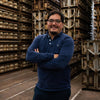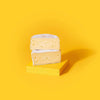Why artisan costs more (or does it?)
By Edward Hancock
Jan 6, 2023

As the New Year is approaching, I thought I'd talk a little about the cost of cheese, and why artisan is more expensive.
As an industry, we have not always done a great job of communicating why artisan cheese commands a higher price than mass-produced, ‘supermarket’ cheese. As the cost of living crisis bites, and we all become more conscious about expense, it is more important than ever that cheesemongers such as cheesegeek provide clarity on where those extra £s go when you make the decision to purchase artisan. Because that decision really is the difference between a positive future for dairy farming, cheesemaking and the land we derive our incredible produce from, and a precarious, unsustainable far less romantic one.
Visiting Fen Farm Dairy, it quite quickly becomes apparent how much ‘easier’ cheesemaking could be. For Baron Bigod, a team of cheesemakers hand ladling curds, only one machine in sight, a salting machine. This could almost entirely be mechanised, which would allow a far quicker make, and could well result in more consistency in the cheese. It would also reduce the need for all those cheesemakers.
So why doesn’t this happen? It comes down to those little beautiful curds, the cheesemakers’ babies. "The size, shape and moisture content of these curds matter enormously to the outcome of the cheese, but so does the fact they are immensely delicate". Too much disruption can create unwanted flavour, reducing the quality of the final product…not necessarily the difference between a good and bad cheese, but the difference between a good and a great cheese (this is the same reason that cheesemakers gravity feed their milk into their cheesemaking vats wherever possible, and even if they use pumps, they are very low pressure, specifically designed for cheesemaking).
With so many variables every day, ranging from the milk through to the weather, the skill, experience and knowledge of these cheesemakers (that a machine could remove the need for) is what makes the cheese the best it can be each day. Not the same, but the best. After all, the romance and intrigue of variety is what has always drawn me to great artisan cheese. The same cheese never tastes exactly the same.
Just a few yards away, Julie Cheyney and Blake Bowden are making St Jude and St Helena in tiny batches, by hand, themselves, in the room that Jonny started in, in those early years of making Bigod. Two great craftspeople, still making their cheese with their own fair hands.
In terms of scarcity, we accept without question that a fillet steak is a more expensive cut than a rib-eye. Not because it’s lean, because the rump is lean too. But because it is the scarcest part of the cow. So, if you think that Cathedral City produce 77k tonnes of cheese a year, and the threshold for inclusion at the artisan cheese awards each year is no more than 400 tonnes a year being made, you can see the difference in scale. You begin to understand why their cheese commands a higher price. Each piece of artisan cheese is special. We could even say, in the era of NFTs, each piece of cheese you purchase is the right to enjoy something totally unique. A piece of history. Because that cheese has never tasted exactly the same before, and it will never taste exactly the same again. There is certainly value in that.
Gazing across the Fen, at the Montbeliarde cows grazing happily, imported specifically to make this cheese, it strikes me as a beautiful thing that Julie moved to the area specifically to make her cheese with the raw milk from these particular cows, such is its quality for cheesemaking. A cheese pilgrimage, ensuring we don’t lose artists like Julie from the cheesemaking game.
These cows are pasture fed as long as the weather allows, which in practice is around 8-9 months of the year, and during the winter their sustenance is feed produced primarily on Fen Farm.
The land is treated with the utmost respect, with over 60 acres currently left alone to regenerate. In addition, over 70% of the energy usage at the farm is green, produced via investments such as solar panels and a manure powered heat exchange. They have even employed a dedicated climate responsibility officer.
It reminds me of my visit to the Jones’, makers of Lincolnshire Poacher, who go even further and thanks to their wind turbine, generate more energy than they use. They also reduce food miles drastically by growing all the food required for their cows on site.
Patrick Holden, owner of Hafod cheese, puts it succinctly when he describes value, but also present vs future cost. When we purchase a cheaper piece of mass-produced cheddar, there is a cost, far greater, than the monetary value of exchange. It is the cost to our environment, both today and going forward that WILL have to be paid for, by us, at some stage. A quick ‘google’ of ‘cheesemaker pollution’ will bring up articles on the damage to the environment caused by factory scale cheesemaking. Not only is artisan cheese great value, but the cost reflects the quality, romance and craftsmanship of the product, as well as the stewardship and protection of our incredible land, that provides all the raw materials to make such a wonderful product.
I leave you with a thought from my recent visit to Martin Gott in Cumbria. He uses his very own starter cultures to make St James. When he described the process to me, I remarked he could make life a lot easier, and cheaper for himself. But the fact is, those starter cultures that he uses for St James, rather than bulk starter bought in, provide his cheeses with not only unique character, but also tell the story of his land. St James sits on our plate, wildly different every time, and tells us about the weather that day, the cow’s lunch, and even the mood of the cheesemaker (trust me, it makes a difference!). It is such a hard cheese to make, it is time consuming, and it is a labour of love.
But when you sit there with a piece of St James in front of you (if you’re lucky enough to get hold of one!) and it dazzles your palate with flavour gymnastics, just think about the romance of that moment. And your connection to the soil, the cows and the cheesemaker. The Jones brothers, Martin Gott, Jonny Crickmore, Julie Cheyney. Stacey Hedges, or Mike Smales. "Imagine that this piece of cheese represents the future of the dairy industry, and our environment." And try and imagine what value you would place on that both now, but also for future generations.
That is a little piece of what artisan cheese is all about, and why it does cost more now. But in the long run, it will cost far far less, and through our choices, we all hold the power. Thanks to everyone who has supported us through 2022 and we look forward to welcoming you back in 2023.
Edward, Founder


